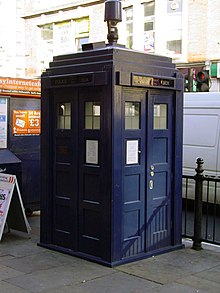Police cell

A police cell is a public, multifunctional cell with a telephone or telecommunications connection . The cells were mainly used by the US and UK police in the 20th century . The shape and size are mostly similar to that of a telephone booth . The Japanese kobans are larger and have more functions.
Functions
For the citizens
- Call the nearest police station using a phone that can be reached in the door and from outside.
- Modern cells offer access to an extensive electronic information system used by the police.
For the cops
- Telephone contact to the nearest police station.
- Detection of offenders within the cell.
- Access to a crime register, first aid kit, and other police tools.
history
The first police cell was built in Albany , USA, in 1877 . Further copies followed in Washington, DC in 1883 , in Chicago and Detroit in 1884 and in Boston in 1885 .
The invention was later introduced in the UK as well. The first British cell was established in Glasgow in 1891 ; it was hexagonal, red, and had a gas lamp on the roof. The first rectangular model appeared in Sunderland in 1923 . Newcastle followed in 1925 and, from 1928, London too . British police cells were usually blue; in Glasgow they only had this color from the late 1960s .
In 1953 there were a total of 685 police cells in London. They played an important role in everyday police life until around 1970. Then they lost their importance with the introduction of police radio . From 1997 the concept was revived and new cells started to be built in some cities in Great Britain. In keeping with the times, these now had more functions such as cameras and a modern telephone. Newer types are more like a kind of Police InfoPoint .
Precipitation in popular culture
The old-fashioned police cells are also very well known in recent times because the TARDIS time machine from the TV series Doctor Who looks like one. As an explanation for this, the series gives a technical defect in the built-in camouflage mechanism, which is actually supposed to fit into the environment of the respective time period. In Great Britain in particular, the cells therefore have a special cult status.
Gallery of some copies
Variant in Edinburgh
TARDIS , prop from the Doctor Who series
Variant in Sheffield
Older model in Covent Garden
Web links
Footnotes
- ^ A b Robert W. Stewart: The Police Signal Box: A 100 Year History (PDF) University of Strathclyde . S. June 2, 1994. Retrieved January 17, 2007.
- ^ Police box offering hi-tech help . In: BBC News , August 24, 2005. Retrieved January 17, 2007.
- ^ Robert W. Stewart: The Police Signal Box: A 100 Year History (PDF) University of Strathclyde . S. June 14, 1994. Retrieved January 17, 2007.
- ^ A b Robert W. Stewart: The Police Signal Box: A 100 Year History (PDF) University of Strathclyde . S. June 3, 1994. Retrieved January 17, 2007.
- ^ A b Robert W. Stewart: The Police Signal Box: A 100 Year History (PDF) University of Strathclyde . S. June 5, 1994. Retrieved January 17, 2007.
- ^ Peter Darrington: Police Box History . In: Police Box website . Archived from the original on September 30, 2007. Info: The archive link was inserted automatically and has not yet been checked. Please check the original and archive link according to the instructions and then remove this notice. Retrieved January 17, 2007.
- ^ A b History of the Metropolitan Police Services - Police Boxes . In: Metropolitan Police website . Archived from the original on November 8, 2008. Retrieved January 17, 2007.
- ^ Robert W. Stewart: The Police Signal Box: A 100 Year History (PDF) University of Strathclyde . S. June 13, 1994. Retrieved January 17, 2007.
- ^ Robert W. Stewart: The Police Signal Box: A 100 Year History (PDF) University of Strathclyde . S. June 8, 1994. Retrieved January 17, 2007.





